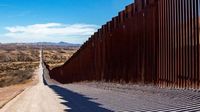In a move that has reignited fierce debate over border security and immigration policy, Homeland Security Secretary Kristi Noem announced on August 20, 2025, that the United States will paint its southern border wall black. The decision, made public during a press conference in Santa Teresa, New Mexico, is intended to serve as an additional physical deterrent to those seeking to cross the border illegally from Mexico into the U.S.
Noem, standing before a towering segment of the border wall and wielding a paint roller herself, credited President Donald Trump with the idea. "That is specifically at the request of the president, who understands that in the hot temperatures down here when something is painted black, it gets even warmer, and it will make it even harder for people to climb," Noem said, according to Border Report and New York Daily News. She further emphasized on social media that the goal is to make the wall "so hot to the touch" that it would discourage anyone from attempting to scale it.
This isn't the first time the notion of painting the border wall black has surfaced. President Trump advocated for the color change as early as 2020, with The Washington Post reporting at the time that the added cost could be upwards of $500 million. While some segments were painted during Trump’s first term, the effort was soon criticized for its high price tag and the paint’s tendency to peel. Now, with a renewed push and a much larger budget, the administration aims to finish the job.
The wall itself is an imposing structure, ranging from 18 to 30 feet in height, with a deep foundation designed to thwart tunneling. Noem highlighted that construction is proceeding at a pace of just under half a mile per day. The design of the wall varies significantly along its 2,000-mile stretch, adapting to the topography and geography of each location. In some areas, "waterborne infrastructure" will be used, while in others, the wall is topped with a comma-shaped feature to further deter climbing.
Beyond the paint, the Department of Homeland Security is bolstering the wall with advanced technology, including cameras and sensors to detect crossings. Additional temporary barriers—concertina wire, razor wire, chain link fencing, and Normandy-style obstacles—are being deployed, particularly to slow down vehicles used to transport migrants. Customs and Border Protection is also collaborating with the Defense Department and the Texas National Guard to reinforce these efforts.
U.S. Border Patrol Chief Mike Banks, present at the Santa Teresa event, added that painting the wall black will help prevent rusting, offering a practical maintenance benefit alongside its deterrent effect. However, the timeline and total cost of painting the entire wall remain unclear. A Department of Homeland Security spokesperson declined to share specifics, citing the need to protect the integrity of future bids from contractors.
What is clear, however, is the scale of the federal investment. The budget bill signed by President Trump on July 4, 2025, provides $46.5 billion for border infrastructure—including the wall—plus $45 billion for immigration detention facilities and $29.85 billion for hiring and training additional Immigration and Customs Enforcement (ICE) personnel. This "Big Beautiful Bill Act," as some supporters have dubbed it, marks one of the largest single allocations for border security in U.S. history.
Noem was quick to tout the effectiveness of recent border security measures. According to Customs and Border Protection data, the number of people encountered crossing the U.S. southwest border illegally has plummeted in recent months. In July 2025, border agents encountered approximately 7,800 people, a dramatic decrease from about 104,000 in July 2024 and 183,000 in July 2023. "It's not just our southern border that we are concerned with and putting resources into," Noem remarked. "It's every border from our maritime seas to our northern border."
Yet, the move to paint the wall black has drawn sharp criticism from human rights organizations and some local officials. Critics argue that the measure is inhumane, as it could cause severe burns to anyone who touches the wall—many of whom may be desperate individuals seeking safety or a better life. As Border Report noted, human rights groups have voiced strong objections, saying the policy prioritizes physical harm over addressing the root causes of migration.
New Mexico Governor Michelle Lujan Grisham, while welcoming Secretary Noem’s attention to local flood damage during the same trip, made clear her opposition to the administration’s immigration strategy. Spokesperson Michael Coleman told the New York Daily News that Grisham supports federal efforts to combat the drug trade and other criminal activity at the border but rejects "Trump’s mass deportation efforts that would break up families and harm New Mexico’s economy and communities." Coleman argued that "passing comprehensive immigration reform legislation would be more effective than painting a border wall black to injure people who are seeking a better life."
Some observers have also questioned the practicality of the plan. Social media users, particularly on Reddit, mocked the proposal, pointing out that border temperatures can drop dramatically at night and in winter, making the wall cold rather than hot. In places like Columbus, New Mexico, daily temperatures can swing from the upper 60s to the upper 20s, challenging the premise that heat alone will be a consistent deterrent.
At the same time, the broader context of border security remains complex and contentious. In Texas, for example, over 50 massage parlors recently had their licenses revoked amid human and sex trafficking investigations, highlighting the multifaceted challenges facing law enforcement along the border. Meanwhile, Mexican President Claudia Sheinbaum expressed frustration that she was not informed about the DEA’s launch of a new binational collaboration called Gatekeeper, underscoring ongoing communication gaps between the two countries.
For supporters of the administration’s approach, the declining number of illegal crossings is evidence that the wall and related policies are working. For critics, however, the focus on physical barriers and punitive measures misses the bigger picture and risks causing unnecessary harm. As the debate continues, one thing is certain: the border wall—now set to be painted black—remains a potent symbol of America’s ongoing struggle to balance security, compassion, and practicality at its frontiers.
With the paint still drying and opinions far from settled, the border wall stands as a testament to the nation’s enduring divisions over how best to manage its borders and its future.






